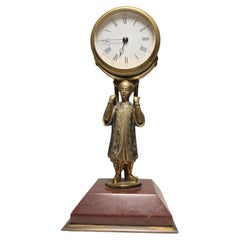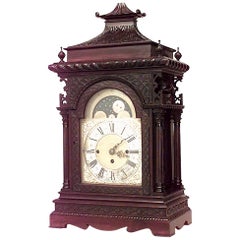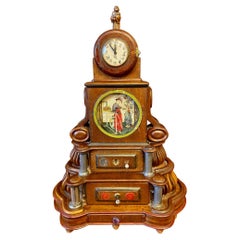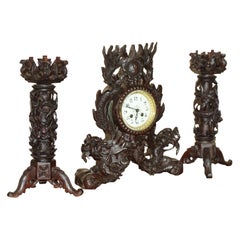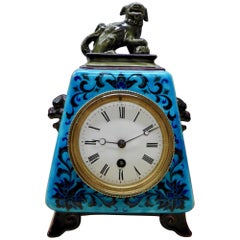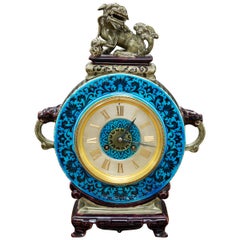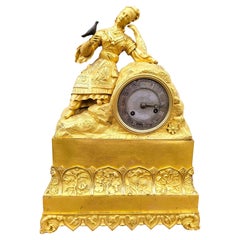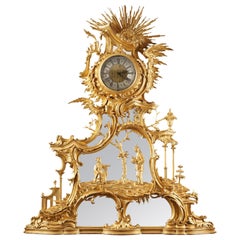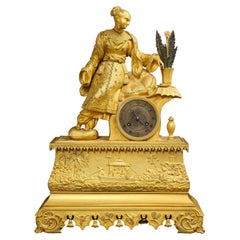Chinese Antique Clocks
Early 1900s Chinese Antique Clocks
Bronze
19th Century English Chinese Chippendale Chinese Antique Clocks
Mahogany
Early 20th Century Chinese Art Deco Chinese Antique Clocks
Mahogany
19th Century Chinese Chinese Export Chinese Antique Clocks
Wood
19th Century French Chinese Antique Clocks
Ceramic
1880s French Other Chinese Antique Clocks
Ceramic
19th Century French Restauration Chinese Antique Clocks
Bronze
1860s English Chinese Chippendale Chinese Antique Clocks
Giltwood
19th Century French Louis XVI Chinese Antique Clocks
Bronze
1920s Swiss Art Deco Chinese Antique Clocks
Marble
19th Century Chinoiserie Chinese Antique Clocks
Wood
1920s British Chinese Export Chinese Antique Clocks
Lacquer
19th Century English Baroque Chinese Antique Clocks
Wood
Late 19th Century French Chinese Export Chinese Antique Clocks
Brass
Late 19th Century French Chinoiserie Chinese Antique Clocks
Ormolu
1880s German High Victorian Chinese Antique Clocks
Wood
Late 19th Century English Chinese Chippendale Chinese Antique Clocks
Mahogany
18th Century English Chippendale Chinese Antique Clocks
Mahogany
Late 19th Century French Chinoiserie Chinese Antique Clocks
Bronze
Mid-19th Century Chinese Qing Chinese Antique Clocks
Brass
Late 19th Century Korean Edo Chinese Antique Clocks
Paper
Early 1900s English Chinese Chippendale Chinese Antique Clocks
Wood
18th Century and Earlier Chinese Rococo Chinese Antique Clocks
Bronze
1830s Chinese Chinese Export Chinese Antique Clocks
Brass, Steel
19th Century French Chinoiserie Chinese Antique Clocks
Metal, Bronze
Early 19th Century Chinese Georgian Chinese Antique Clocks
Rosewood
Mid-18th Century English Chinese Chippendale Chinese Antique Clocks
19th Century Chinese Antique Clocks
Mid-18th Century French Louis XV Chinese Antique Clocks
Bronze
1740s English Chinese Chippendale Chinese Antique Clocks
Lacquer, Paint
Late 19th Century French Louis XV Chinese Antique Clocks
Bronze
19th Century Chinese Chinese Antique Clocks
Nickel
18th Century Chinese Qing Chinese Antique Clocks
Porcelain
18th Century and Earlier English Chinese Antique Clocks
18th Century and Earlier English Chinese Antique Clocks
Bronze
19th Century Chinese Chinese Antique Clocks
Ormolu
Early 20th Century American Chinese Antique Clocks
Jade, Silver
Late 19th Century Chinese Chinese Antique Clocks
Ormolu
19th Century French Chinese Antique Clocks
Late 19th Century French Japonisme Chinese Antique Clocks
Bronze
Early 20th Century American Chinese Antique Clocks
Lapis Lazuli
Late 19th Century French Napoleon III Chinese Antique Clocks
Bronze
Late 19th Century Chinese Antique Clocks
Bronze
Late 19th Century English Chinese Export Chinese Antique Clocks
Early 1900s English Chinese Chippendale Chinese Antique Clocks
Lacquer
Late 18th Century French Louis XV Chinese Antique Clocks
Early 19th Century French Charles X Chinese Antique Clocks
Bronze, Ormolu
19th Century French Chinoiserie Chinese Antique Clocks
Bronze
1760s English Chinese Chippendale Chinese Antique Clocks
Brass
1870s European Napoleon III Chinese Antique Clocks
Bronze
Late 18th Century French Louis XV Chinese Antique Clocks
Brass, Iron, Wrought Iron, Enamel
19th Century German Belle Époque Chinese Antique Clocks
Porcelain
19th Century French Aesthetic Movement Chinese Antique Clocks
Porcelain
1860s English Victorian Chinese Antique Clocks
Walnut
Late 19th Century Chinese Rococo Revival Chinese Antique Clocks
Bronze
Late 19th Century French Louis XV Chinese Antique Clocks
Bronze
Early 1900s English Chinese Chippendale Chinese Antique Clocks
Wood
1820s Chinese Chinese Export Chinese Antique Clocks
19th Century Chinese Chinese Antique Clocks
Wood
19th Century Chinese Chinese Antique Clocks
- 1
Chinese Antique Clocks For Sale on 1stDibs
How Much are Chinese Antique Clocks?
- 1stDibs ExpertApril 5, 2022Check the clock for a manufacturer’s mark or label. Once you have this, you should be able to look up the clock’s brand to see if it is French in origin. A clock is considered antique once it is 100 years old. A professional can also help verify the origin of your clock. Shop an array of expertly vetted antique clocks on 1stDibs.
- 1stDibs ExpertFebruary 27, 2024To identify your antique clock, search for markings on the back of its movement or case. Once you have located these marks, use trusted online resources to determine who the maker is. From there, you can continue your research to learn more about your clock's age, style and other characteristics. An expert appraiser or antiques dealer can also assist you with identification. Find a wide range of antique clocks on 1stDibs.
- How can I spot an antique clock?1 Answer1stDibs ExpertApril 5, 2022To spot whether or not a clock is antique, note if the clockmaker’s name or company is engraved near the center face of the dial. A paper label may also be pasted on the back of the clock. You can shop a collection of expertly vetted antique clocks from some of the world’s top sellers on 1stDibs.
- 1stDibs ExpertOctober 26, 2021An antique bracket clock refers to a portable spring-driven pendulum table clock created in the 17th and 18th centuries. These clocks were equipped with convenient carrying handles and were housed usually in rectangular cases. Shop a collection of antique and vintage bracket clocks from some of the world’s top dealers on 1stDibs.
- 1stDibs ExpertFebruary 17, 2023To know if an antique clock is valuable, you'll typically need to have the piece assessed by a certified appraiser or an experienced antiques dealer. The maker and style of the clock will help determine its value (an early American clockmaker’s antique grandfather model, featuring an oak case and decorative carvings, may be very interesting to collectors, for example). Overall condition of your clock also plays a role. Generally, clocks that still work are worth more than those that require repairs. On 1stDibs, find a selection of antique, vintage and modern clocks.
- 1stDibs ExpertNovember 4, 2024To identify antique Chinese furniture, look carefully at its details. Chinese craftsmen often built furniture using mortise and tenon joinery, eliminating the need for nails and screws. If you see this type of hardware, your piece is likely not at least 100 years old, especially if the hardware still looks new and shiny. Since antique furniture was handmade, you will normally see slight imperfections, such as tool marks or slight variations in carvings. Pieces that appear completely uniform and pristine are less often genuine antiques.
When present, maker's marks can also be helpful. Research the marks to learn more about when the maker was active and producing pieces like yours. Alternatively, you can have a certified appraiser or experienced antique dealer evaluate your furniture for you.
Shop an assortment of antique Chinese furniture.  PAGODA REDOctober 7, 2020
PAGODA REDOctober 7, 2020To determine the age of a Chinese furniture piece, look carefully at the joinery and finish. Natural expansion and contraction of the wood over time will cause a joint to protrude or retract, distorting a once-seamless fit. Antique lacquer finishes become crackled and worn over time. Areas of exposed wood, such as the underside of a table, the footrest of a chair, or the back of a cabinet should appear raw and dry compared to the finished surface. With use, the legs of tables and chairs become weathered near the bottom from precipitation and use.
 Lotus GallerySeptember 23, 2020
Lotus GallerySeptember 23, 2020The best way to know is to take it to an expert, such as an appraiser, reputable dealer or auction house, or museum
- 1stDibs ExpertSeptember 16, 2024Yes, some old antique clocks may be worth something. Many collectors look for clocks produced by certain manufacturers, such as the Ansonia Clock Company, the Seth Thomas Clock Company, Jaeger-LeCoultre and the Chelsea Clock Company. In addition to the maker, the type, materials, style and condition of the clock influence its value. Generally, clocks that remain in good working order are worth more than those in need of repairs and restorations. To find out how much your clock may be worth, consult a certified appraiser or experienced antique dealer. On 1stDibs, explore a large collection of antique clocks.
